Related Research Articles
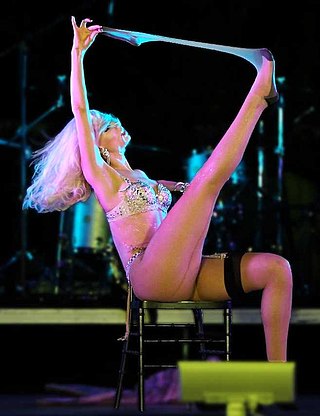
A striptease is an erotic or exotic dance in which the performer gradually undresses, either partly or completely, in a seductive and sexually suggestive manner. The person who performs a striptease is commonly known as a "stripper" or an "exotic" or "burlesque" dancer.

Gypsy Rose Lee was an American burlesque entertainer, stripper, actress, author, playwright and vedette famous for her striptease act. Her 1957 memoir was adapted into the 1959 stage musical Gypsy.

A stripper or exotic dancer is a person whose occupation involves performing striptease in a public adult entertainment venue such as a strip club. At times, a stripper may be hired to perform at private events.

The G-String Murders is a 1941 detective novel written by American burlesque performer Gypsy Rose Lee. There have been claims made that the novel was written by mystery writer Craig Rice, but others have suggested that there is sufficient documented evidence in the form of manuscripts and correspondence to prove Lee wrote at least a large portion, if not the whole, of the novel under the tutelage of editor/friend George Davis with some essential guidance from her good friend Rice. The novel has been published under the titles Lady of Burlesque and The Strip-Tease Murders. Set in a burlesque theater, Lee casts herself as the detective who solves a set of homicides in which strippers in her troupe are found strangled with their own G-strings.

Marie Frances Van Schaack, known professionally as Lili St. Cyr, was a prominent American burlesque dancer and stripper.
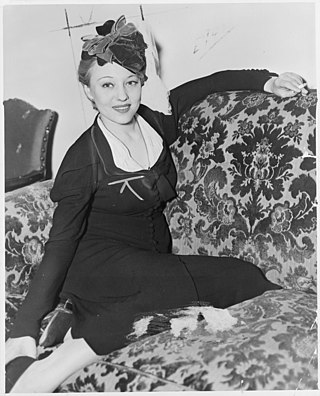
Sally Rand was an American burlesque dancer, vedette, and actress, famous for her ostrich-feather fan dance and balloon bubble dance. She also performed under the name Billie Beck. Rand got her start as a chorus girl before working as an acrobat and traveling theater performer. Her career spanned more than forty years and she appeared on stage, screen and in television. Through her career she worked alongside Humphrey Bogart, Karl Malden, and Cecil B. De Mille. She was a trained pilot and briefly dated Charles Lindbergh.
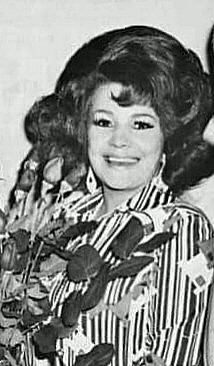
Blaze Starr was an American stripper and burlesque star. Her vivacious presence and inventive use of stage props earned her the nickname "The Hottest Blaze in Burlesque". She was also known for her affair with Louisiana Governor Earl Kemp Long. Based on her memoir Blaze Starr! My Life as Told to Huey Perry, the 1989 film Blaze told the story of that affair starring Paul Newman as Long and Lolita Davidovich as Starr, with Starr herself acting in a cameo role and as a consultant.

The Burlesque Hall of Fame (BHOF) is the world's only museum dedicated to the history, preservation, and future of the art of burlesque. Located in the Las Vegas Arts district at 1027 S Main st. #110, BHOF is a tourist destination and non-profit 501 (c)(3) educational organization offering tours of its vast Collection of costumes, memorabilia, props and ephemera from burlesque's heyday through contemporary practice; classes for individuals and groups at all levels including beginner; movie screenings; research access for students and journalists; and a gift shop.
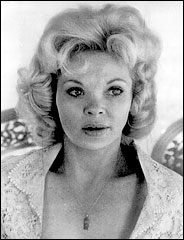
Juanita Dale Slusher, better known by her stage name Candy Barr, was an American stripper, burlesque dancer, actress, and adult model in men's magazines of the mid-20th century.

Tempest Storm, also dubbed "The Queen Of Exotic Dancers," was an American burlesque star and motion picture actress. Along with Lili St. Cyr, Sally Rand, and Blaze Starr, she was one of the best-known burlesque performers of the 1950s, 1960s, and 1970s. Her career as an exotic dancer spanned more than 60 years, and she was still performing in the early 21st century.
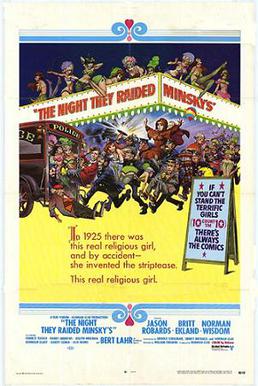
The Night They Raided Minsky's is a 1968 American musical comedy film written and produced by Norman Lear, with music and lyrics by the duo of Charles Strouse and Lee Adams, and directed by William Friedkin. Based on a 1960 novel by Rowland Barber, the film is a fictional account of the invention of the striptease at Minsky's Burlesque in 1925. It stars Jason Robards, Britt Ekland, Norman Wisdom, Forrest Tucker, Harry Andrews, Denholm Elliott, Elliott Gould and Bert Lahr.
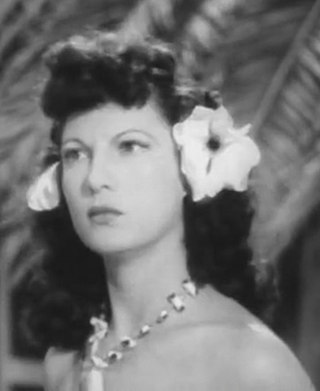
Ann Corio was a prominent American burlesque stripper and actress. Her original surname was Coiro, changing it to Corio for stage purposes and because some family members did not approve of her profession.
Minsky's Burlesque refers to the brand of American burlesque presented by four sons of Louis and Ethel Minsky: Abraham 'Abe' Bennett Minsky (1880–1949), Michael William 'Billy' Minsky (1887–1932), Herbert Kay Minsky (1891–1959), and Morton Minsky (1902–1987). They started in 1912 and ended in 1937 in New York City. Although the shows were declared obscene and outlawed, they were rather tame by modern standards.
Hinda Wausau (1906–1980) aka Hinda Wassau, Hinda Wasau, or Hindu Wausau, was a star stripteaser in burlesque. She claimed, and has been credited with, inadvertently inventing the striptease around 1928 at either the Haymarket or State-Congress Theater in Chicago when her costume started coming off during a shimmy dance.

Edith Zack, better known by the stage name Sherry Britton, was an American burlesque performer of the 1930s and early 1940s. The 5-foot-3-inch (1.60 m) Britton had an 18-inch (46 cm) waist, and was once said to have a "figure to die for."

Betty Jane Rowland was an American burlesque dancer and actress, with a career spanning over eight decades. She was the last living performer of the "Golden Age of Burlesque" era.
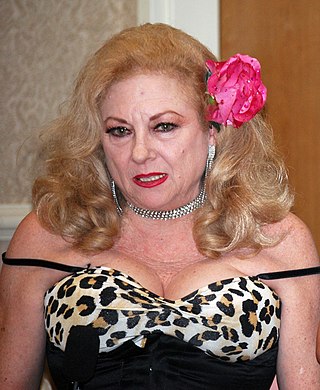
Angel Cecelia Helene Walker was an American exotic dancer specializing in stripping and burlesque under her stage name Satan's Angel.

American burlesque is a genre of variety show derived from elements of Victorian burlesque, music hall, and minstrel shows. Burlesque became popular in the United States in the late 1860s and slowly evolved to feature ribald comedy and female nudity. By the late 1920s, the striptease element overshadowed the comedy and subjected burlesque to extensive local legislation. Burlesque gradually lost its popularity, beginning in the 1940s. A number of producers sought to capitalize on nostalgia for the entertainment by recreating burlesque on the stage and in Hollywood films from the 1930s to the 1960s. There has been a resurgence of interest in this format since the 1990s.

The Mutual Burlesque Association, also called the Mutual Wheel or the MBA, was an American burlesque circuit active from 1922 until 1931. Controlled by Isidore Herk, it quickly replaced its parent company and competitor, the Columbia Amusement Company, as the preeminent burlesque circuit during the Roaring Twenties. Comedians Bud Abbott, Lou Costello, Harry Steppe, Joe Penner, Billy Gilbert, Rags Ragland, and Billy Hagan, as well as stripteasers Ann Corio, Hinda Wausau, Gypsy Rose Lee, and Carrie Finnell, performed in Mutual shows. Mae West appeared in Mutual shows from 1922 to 1925. Mutual collapsed during the Great Depression.
References
- 1 2 3 4 5 6 7 8 9 10 11 Watson, Sonny. "April March". www.streetswing.com. Retrieved 16 June 2018.
- 1 2 3 "Biography". April March, First Lady Of Burlesque. Archived from the original on 11 August 2011. Retrieved 16 June 2018.
- ↑ Lynch, Annette (2013). Porn Chic: Exploring the Contours of Raunch Eroticism. A&C Black. ISBN 9781472520142.
- 1 2 Serena Doherty (10 June 2013). "Six Professional Peelers of 50s Burlesque". Burlexe. Retrieved 16 June 2018.
- 1 2 3 4 5 6 7 8 9 10 11 Steve Barnes (October 15, 2016). "81-year-old burlesque dancer bares secrets in autobiography". Times Union. Retrieved 16 June 2018.
- 1 2 3 4 5 6 7 8 9 10 Adele Wolf (1 October 2014). "Speaking with Legends: April March 'The First Lady of Burlesque'". 21st Century Burlesque Magazine. Retrieved 16 June 2018.
- 1 2 3 4 Ann Marie French (5 July 2010). "Local resident and former burlesque star April March attends 'Behind the Burly Q' film premier". Saratogian News. Retrieved 16 June 2018.
- 1 2 3 4 5 6 Rosey La Rouge (12 February 2017). "Ice Cream Social with "The First Lady of Burlesque"". burlesquebeat.com. Retrieved 16 June 2018.
- ↑ "BHOF Finishing School Master Classes 2012". www.burlesquehall.com. May 21, 2012. Retrieved 16 June 2018.
- ↑ "Behind the Burly Q (2010)". IMDb . Retrieved 16 June 2018.
- ↑ "Burlesque Undressed (2010)". IMDb. Retrieved 16 June 2018.